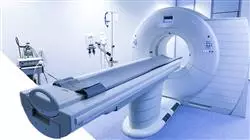University certificate
The world's largest school of business”
Introduction to the Program
Health is a sector with broad expectations for the future. Bet on this program and get trained to lead business projects related to the Analysis of Biomedical Images and Big Data”

Why Study at TECH?
TECH is the world's largest 100% online business school. It is an elite business school, with a model based on the highest academic standards. A world-class center for intensive managerial skills education.
TECH is a university at the forefront of technology, and puts all its resources at the student's disposal to help them achieve entrepreneurial success”
At TECH Global University
|
|
Innovation |
The university offers an online learning model that balances the latest educational technology with the most rigorous teaching methods. A unique method with the highest international recognition that will provide students with the keys to develop in a rapidly-evolving world, where innovation must be every entrepreneur’s focus.
"Microsoft Europe Success Story", for integrating the innovative, interactive multi-video system.
|
|
The Highest Standards |
Admissions criteria at TECH are not economic. Students don't need to make a large investment to study at this university. However, in order to obtain a qualification from TECH, the student's intelligence and ability will be tested to their limits. The institution's academic standards are exceptionally high...
95% of TECH students successfully complete their studies
|
|
Networking |
Professionals from countries all over the world attend TECH, allowing students to establish a large network of contacts that may prove useful to them in the future.
100,000+ executives prepared each year, 200+ different nationalities.
|
|
Empowerment |
Students will grow hand in hand with the best companies and highly regarded and influential professionals. TECH has developed strategic partnerships and a valuable network of contacts with major economic players in 7 continents.
500+ collaborative agreements with leading companies.
|
|
Talent |
This program is a unique initiative to allow students to showcase their talent in the business world. An opportunity that will allow them to voice their concerns and share their business vision.
After completing this program, TECH helps students show the world their talent.
|
|
Multicultural Context |
While studying at TECH, students will enjoy a unique experience. Study in a multicultural context. In a program with a global vision, through which students can learn about the operating methods in different parts of the world, and gather the latest information that best adapts to their business idea.
TECH students represent more than 200 different nationalities.

|
|
Learn with the best |
In the classroom, TECH’s teaching staff discuss how they have achieved success in their companies, working in a real, lively, and dynamic context. Teachers who are fully committed to offering a quality specialization that will allow students to advance in their career and stand out in the business world.
Teachers representing 20 different nationalities.
TECH strives for excellence and, to this end, boasts a series of characteristics that make this university unique:
|
|
Analysis |
TECH explores the student’s critical side, their ability to question things, their problem-solving skills, as well as their interpersonal skills.
|
|
Academic Excellence |
TECH offers students the best online learning methodology. The university combines the Relearning methodology (the most internationally recognized postgraduate learning methodology) with Harvard Business School case studies. A complex balance of traditional and state-of-the-art methods, within the most demanding academic framework.
|
|
Economy of Scale |
TECH is the world’s largest online university. It currently boasts a portfolio of more than 10,000 university postgraduate programs. And in today's new economy, volume + technology = a ground-breaking price. This way, TECH ensures that studying is not as expensive for students as it would be at another university.
At TECH, you will have access to the most rigorous and up-to-date case analyses in academia”
Syllabus
One of the keys to the success of TECH Global University is the use of the innovative and effective Relearning methodology in the development of the theoretical content of all its degrees, which consists of the reiteration of the most important concepts throughout length of the topic. In addition, this pedagogical strategy is based on the resolution of practical, simulated and real cases. Both aspects favor an acquisition of gradual and natural knowledge, without the need to invest long and tedious hours of study with traditional memorization techniques.
Would you like to master technical aspects of magnetic resonance, ultrasound or computed tomography to create business projects? If the answer is yes, enroll now"
Syllabus
The Postgraduate diploma in Biomedical Image Analysis and Big Data in E-Health offered by TECH Global University is an intensive and multidisciplinary program that will prepare the graduate to face the labor market and the most ambitious and complex projects in as bioinformatics and the telemedicine sector, with the guarantee of having the most up-to-date and complete knowledge.
The content of the program is designed to broaden the student's professional skills, through the mastery of the tools that are currently being used, both for research in the health sciences and for data management.
This is a program in which you will have 450 hours of the best theoretical, practical and additional material, with which you will be able to delve into the applications of this area and adapt your profile to the labor demand that currently exists in the professional sector.
This Postgraduate diploma takes place over 6 months and is divided into 3 modules:
Module 1. Techniques, Recognition and Intervention using Biomedical Imaging
Module 2. Big Data in Medicine: Massive Medical Data Processing
Module 3. Applications of Artificial Intelligence and the Internet of Things (IoT) in Telemedicine

Where, When and How is it Taught?
TECH offers the possibility of developing this Postgraduate diploma in Biomedical Image Analysis and Big Data in E-Health completely online. Over the course of 6 months, you will be able to access all the contents of this program at any time, allowing you to self-manage your study time.
Module 1. Techniques, Recognition and Intervention using Biomedical Imaging
1.1. Medical Imaging
1.1.1. Modalities in Medical Imaging
1.1.2. Objectives in Medical Imaging Systems
1.1.3. Medical Imaging Storage Systems
1.2. Radiology
1.2.1. Imaging Method
1.2.2. Radiology Interpretation
1.2.3. Clinical Applications
1.3. Computed Tomography (CT)
1.3.1. Principle of Operation
1.3.2. Image Generation and Acquisition
1.3.3. Computerized Tomography. Typology
1.3.4. Clinical Applications
1.4. Magnetic Resonance Imaging (MRI)
1.4.1. Principle of Operation
1.4.2. Image Generation and Acquisition
1.4.3. Clinical Applications
1.5. Ultrasound: Ultrasound and Doppler Sonography
1.5.1. Principle of Operation
1.5.2. Image Generation and Acquisition
1.5.3. Typology
1.5.4. Clinical Applications
1.6. Nuclear medicine
1.6.1. Physiological Basis in Nuclear Studies. Radiopharmaceuticals and Nuclear Medicine
1.6.2. Image Generation and Acquisition
1.6.3. Types of Tests
1.6.3.1. Gammagraphy
1.6.3.2. SPECT
1.6.3.3. PET
1.6.3.4. Clinical Applications
1.7. Image-Guided Interventions
1.7.1. Interventional Radiology
1.7.2. Interventional Radiology Objectives
1.7.3. Procedures
1.7.4. Advantages and Disadvantages.
1.8. Image Quality
1.8.1. Technique
1.8.2. Contrast
1.8.3. Resolution
1.8.4. Noise
1.8.5. Distortion and Artifacts
1.9. Medical Imaging Tests. Biomedicine
1.9.1. Creating 3D Images
1.9.2. Biomodels
1.9.2.1. DICOM Standard
1.9.2.2. Clinical Applications
1.10. Radiological Protection
1.10.1. European Legislation Applicable to Radiology Services
1.10.2. Safety and Action Protocols
1.10.3. Radiological Waste Management
1.10.4. Radiological Protection
1.10.5. Care and Characteristics of Rooms
Module 2. Big Data in Medicine: Massive Medical Data Processing
2.1. Big Data in Biomedical Research
2.1.1. Data Generation in Biomedicine
2.1.2. High-Throughput Technology
2.1.3. Uses of High-Throughput Data. Hypotheses in the Age of Big Data
2.2. Data Pre-Processing in Big Data
2.2.1. Data Pre-Processing
2.2.2. Methods and Approaches
2.2.3. Problems with Data Pre-Processing in Big Data
2.3. Structural Genomics
2.3.1. Sequencing the Human Genome
2.3.2. Sequencing vs. Chips
2.3.3. Variant Discovery
2.4. Functional Genomics
2.4.1. Functional Notation
2.4.2. Mutation Risk Predictors
2.4.3. Association Studies in Genomics
2.5. Transcriptomics
2.5.1. Techniques to Obtain Massive Data in Transcriptomics: RNA-seq
2.5.2. Data Normalization in Transcriptomics
2.5.3. Differential Expression Studies
2.6. Interactomics and Epigenomics
2.6.1. The Role of Cromatine in Gene Expression
2.6.2. High-Throughput Studies in Interactomics
2.6.3. High-Throughput Studies in Epigenetics
2.7. Proteomics
2.7.1. Analysis of Mass Spectrometry Data
2.7.2. Post-Translational Modifications Study
2.7.3. Quantitative Proteomics
2.8. Enrichment and Clustering Techniques
2.8.1. Contextualizing Results
2.8.2. Clustering Algorithms in Omics Techniques
2.8.3. Repositories for Enrichment: Gene Ontology and KEGG
2.9. Applying Big Data to Public Health
2.9.1. Discovery of New Biomarkers and Therapeutic Targets
2.9.2. Risk Predictors
2.9.3. Personalized Medicine
2.10. Big Data Applied to Medicine
2.10.1. Potential for Diagnostic and Preventive Assistance
2.10.2. Use of Machine Learning Algorithms in Public Health
2.10.3. The Problem of Privacy
Module 3. Applications of Artificial Intelligence and the Internet of Things (IoT) in Telemedicine
3.1. E-Health Platforms. Personalizing Healthcare Services
3.1.1. E-Health Platform
3.1.2. Resources for E-Health Platforms
3.1.3. Digital Europe Program. Digital Europe-4-Health and Horizon Europe
3.2. Artificial Intelligence in Healthcare I: New Solutions in Computer Applications
3.2.1. Remote Analysis of Results
3.2.2. Chatbox
3.2.3. Prevention and Real-Time Monitoring
3.2.4. Preventive and Personalized Medicine in Oncology
3.3. Artificial Intelligence in Healthcare II: Monitoring and Ethical Challenges
3.3.1. Monitoring Patients with Reduced Mobility
3.3.2. Cardiac Monitoring, Diabetes, Asthma
3.3.3. Health and Wellness Apps
3.3.3.1. Heart Rate Monitors
3.3.3.2. Blood Pressure Bracelets
3.3.4. Ethical Use of AI in the Medical Field. Data Protection
3.4. Artificial Intelligence Algorithms for Image Processing
3.4.1. Artificial Intelligence Algorithms for Image Handling
3.4.2. Image Diagnosis and Monitoring in Telemedicine
3.4.2.1. Melanoma Diagnosis
3.4.3. Limitations and Challenges in Image Processing in Telemedicine
3.5. Application Acceleration using Graphics Processing Units (GPU) in Medicine
3.5.1. Program Parallelization
3.5.2. GPU Operations
3.5.3. Application Acceleration using GPU in Medicine
3.6. Natural Language Processing (NLP) in Telemedicine
3.6.1. Text Processing in the Medical Field. Methodology
3.6.2. Natural Language Processing in Therapy and Medical Records
3.6.3. Limitations and Challenges in Natural Language Processing in Telemedicine
3.7. The Internet of Things (IoT) in Telemedicine. Applications
3.7.1. Monitoring Vital Signs. Wearables
3.7.1.1. Blood Pressure, Temperature, and Heart Rate
3.7.2. The IT and Cloud Technology
3.7.2.1. Data Transmission to the Cloud
3.7.3. Self-Service Terminals
3.8. The IT in Patient Monitoring and Care
3.8.1. The IT Applications for Emergency Detection
3.8.2. The Internet of Things in Patient Rehabilitation
3.8.3. Artificial Intelligence Support in Victim Recognition and Rescue
3.9. Nano-Robots. Typology
3.9.1. Nanotechnology
3.9.2. Types of Nano-Robots
3.9.2.1. Assemblers. Applications
3.9.2.2. Self-Replicating. Applications
3.10. Artificial Intelligence in COVID-19 Control
3.10.1. Covid- 19 and Telemedicine
3.10.2. Management and Communication of Breakthroughs and Outbreaks
3.10.3. Outbreak Prediction in Artificial Intelligence

In the virtual classroom you will find research articles, complementary readings, detailed videos and dynamic summaries to delve into each section of the agenda”
Postgraduate Diploma in Biomedical Image Analysis and Big Data in e-Health
Big Data currently represents an opportunity to streamline procedures in telemedicine. COVID reflected the importance of having worldwide data processing that glimpses the changing data of this disease. In addition, the public administration has shown great interest in simplifying healthcare processes. All of this is focused on personalized and individualized health care. For this reason, the specialists of the present and the future must master strategies in biomedical imaging and, in addition, in Big Data. Are you passionate about the world of technology applied to health? Do you want to become an expert in the analysis of biomedical images and big data in e-Health? Then, the Postgraduate Diploma in Biomedical Image Analysis and Big Data in e-Health is the perfect educational program for you. This educational program is designed for all those professionals who wish to expand their knowledge in the field of health and technology. The main objective of the specialization is to train specialists in biomedical image analysis and big data applied to healthcare, so that they can develop innovative tools and programs that contribute to the improvement and optimization of the healthcare system.
Don't miss the opportunity to learn about Big Data in the medical field
Throughout TECH's Postgraduate Diploma in Biomedical Image Analysis and Big Data in e-Health, students will receive high-quality preparation in areas such as digital processing of biomedical images, data analysis techniques, databases and information systems, artificial intelligence and machine learning, and other advanced technologies applied to healthcare. In addition, this academic program is designed to be compatible with the students' work pace, which will allow them to combine learning with work.If you want to be a specialist in biomedical image analysis and big data in e-Health, don't hesitate any longer and enroll in the Postgraduate Diploma in Biomedical Image Analysis and Big Data in e-Health!

















